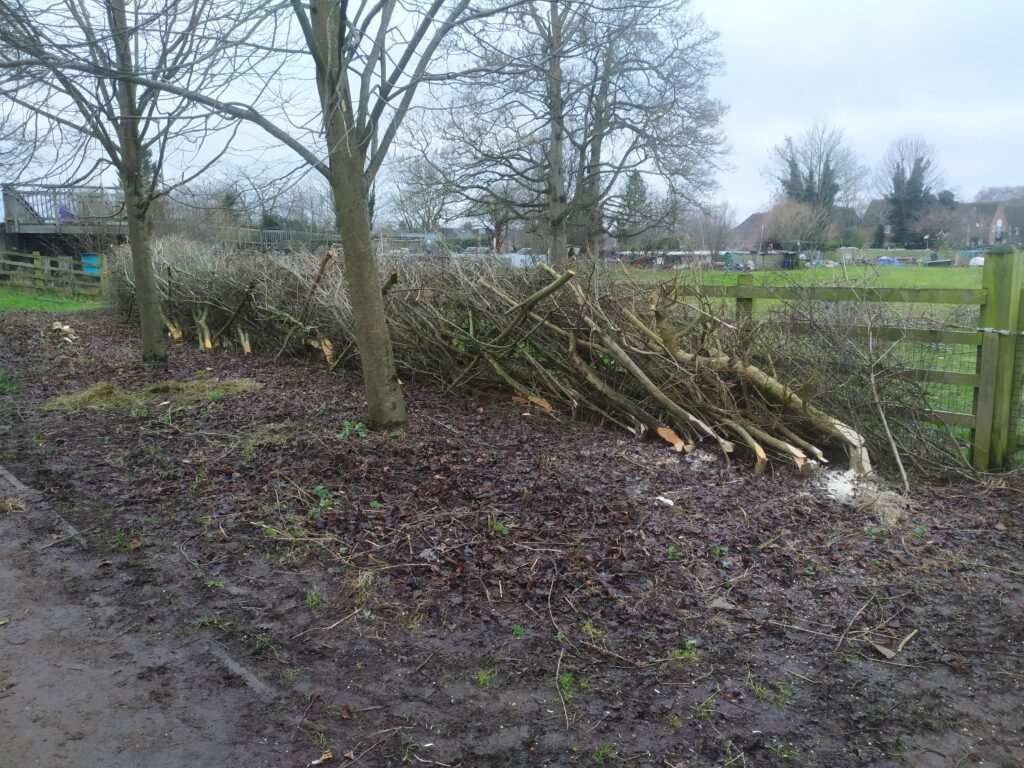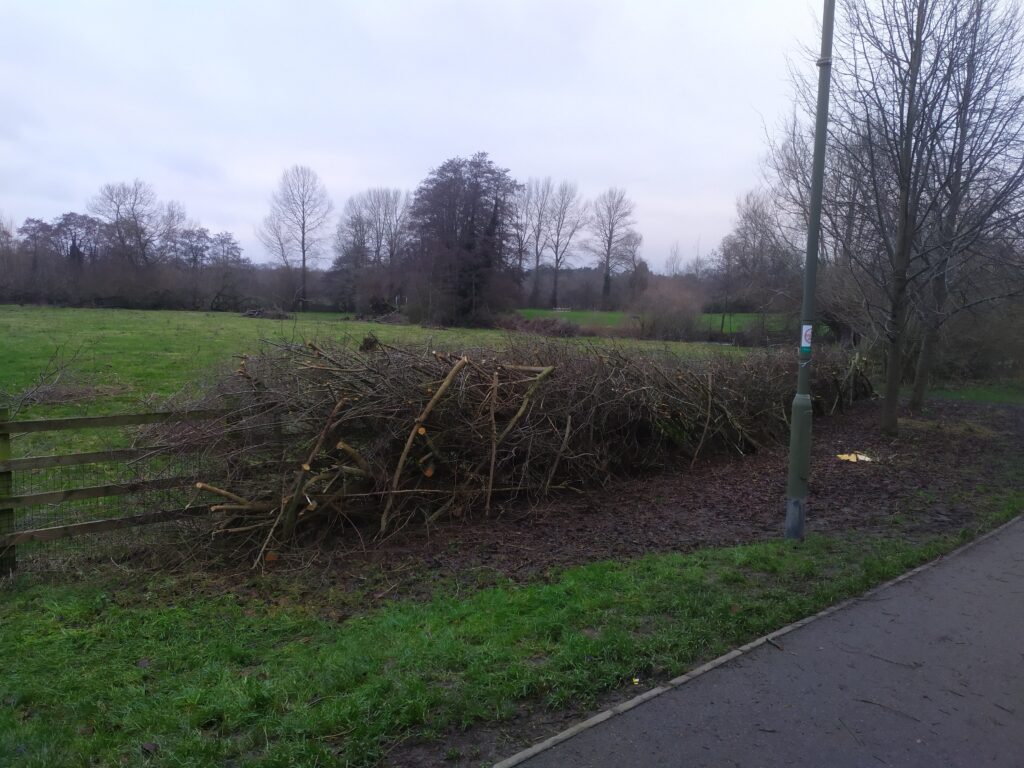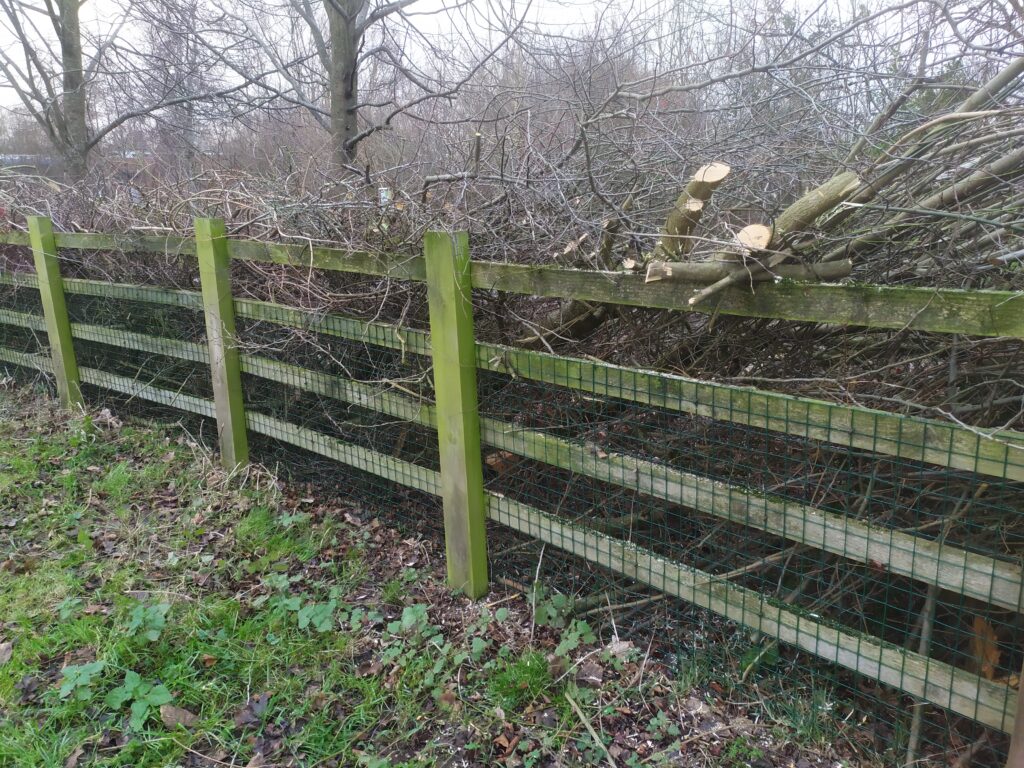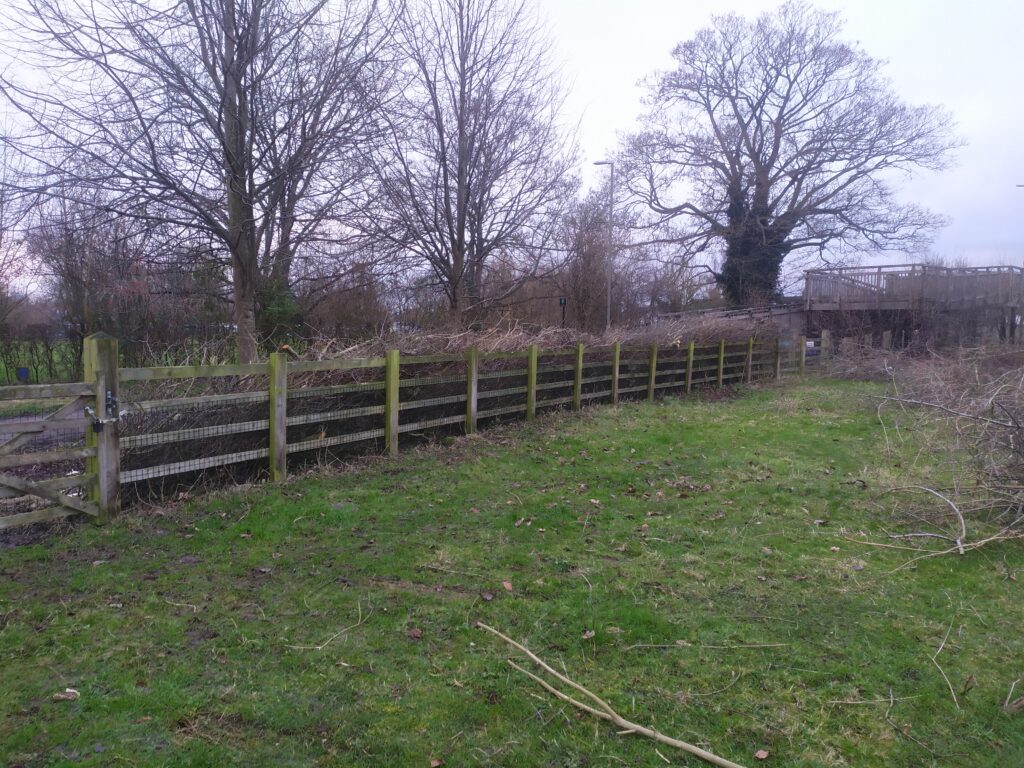You often hear about traditional hedgelaying in conservation projects involved with landscape regeneration, such as NEWT. Which may seem strange to make manmade features into the land for the restoration of nature. Farmers of yesteryear certainly didn’t pay labourers to lay hedges up and down the country for the benefit of the birds either. It might be useful if we take a quick look at why it was done traditionally and why it is done now.
Tradition
Traditional hedgelaying is all about creating a living fence. Farmers need fencing to stop their expensive livestock from wandering off, or an even bigger problem, eating their other crops! Before that days when perfectly round and pointed treated wooden fence posts could be bought with a roll of barb wire relatively inexpensively, this was a problem. Sure primitive fences can be made of wood, but they are labour intensive and tend to not last very long in the elements. Especially where livestock is involved. Most animals are very curious and strong. Cows, pigs and sheep are no exception. Stone walls are only feasible where a ready supply of stone is on hand.
These days we have stock fencing to keep livestock in, traditional hedges were stock hedges. That is why when they are laid, they are often staked and woven to create strength. Different regions in the country developed different techniques that worked well for their local environment, livestock and materials locally available in sufficient quantities. They made their own billhooks that were tailored to work with the local style. Thus hedgelaying styles and types of billhook are often know by their county of origin. The benefit of it living is that it will not rot and need replacing like fencing, but grow stronger time; whilst at the same time, producing materials to maintain it with.
There are many hedglaying societies who compete in competitions, often with long historical backgrounds. Where you will see the different regional traditional techniques being used with a beautiful uniformity and precision that is an absolute pleasure for the eye.
Conservation
So what does this have to to do with people looking to restore natural habitats? Nature is rarely uniform and precise, and surely this is an aberration to rewilding the ‘natural’ environment? Well, there are many reasons…
I think it is a fair guess that ever since humans started rearing animals for food and husbandry, they will have needed fencing, as animals were even more wild then. With a lack of readily available barbed wire, it therefor comes to pass that hedges must have followed pretty soon after. Which is a long time ago. So they are in a sense part of our ‘natural’ habitat, some might say naturalised, and animals have come to love them. In response to centuries of us carving up the country, felling forest, draining bog and clearing scrub; nature has come to rely on the safe-haven of a trusty hedgerow.
They also form useful corridors for wildlife to move around, think of them as the road network for small mammals and the motorway service pitstop for the birds. This is perhaps even more poignant with the onset of climate change and the need for animals to relocate latitude permanently; but is certainly useful in the more mundane day to day and seasonal fluctuation of food sources and predators.
They often contain plants that blossom and produce fruit and berries, which is a good source of food for small mammals and birds. They inevitably contain some dead wood and leaf litter on the floor, which creates a haven for insects, arachnids and all the things that like to eat them. They create shade and moisture for fungi, and woodland bulbs such as snowdrops. Sunny field margins become a haven for perennial wildflowers such as Knapweed.
They are a great habitat for protection from predators when rearing young, where birds will nest in the dense thick thorns, and mice will find little hollows to hide in. With the hedge also providing the building materials they need to make their nests too.
And as for ‘why do anything?’ yes our ambition is generally about rewilding, but where space is at a premium a hedgerow can provide more benefit from the smaller plot. A hedge left to its own devices will after a few years, race away. That is where the trees that have been planted so densely for the hedge, have established good roots but are competing aggressively for light with each other. They will grow very long thin stems with little leaf or fruit as they strive to be the tallest. Traditionally this would have been actively encouraged as such straight long poles have many uses. Fencing for a start.
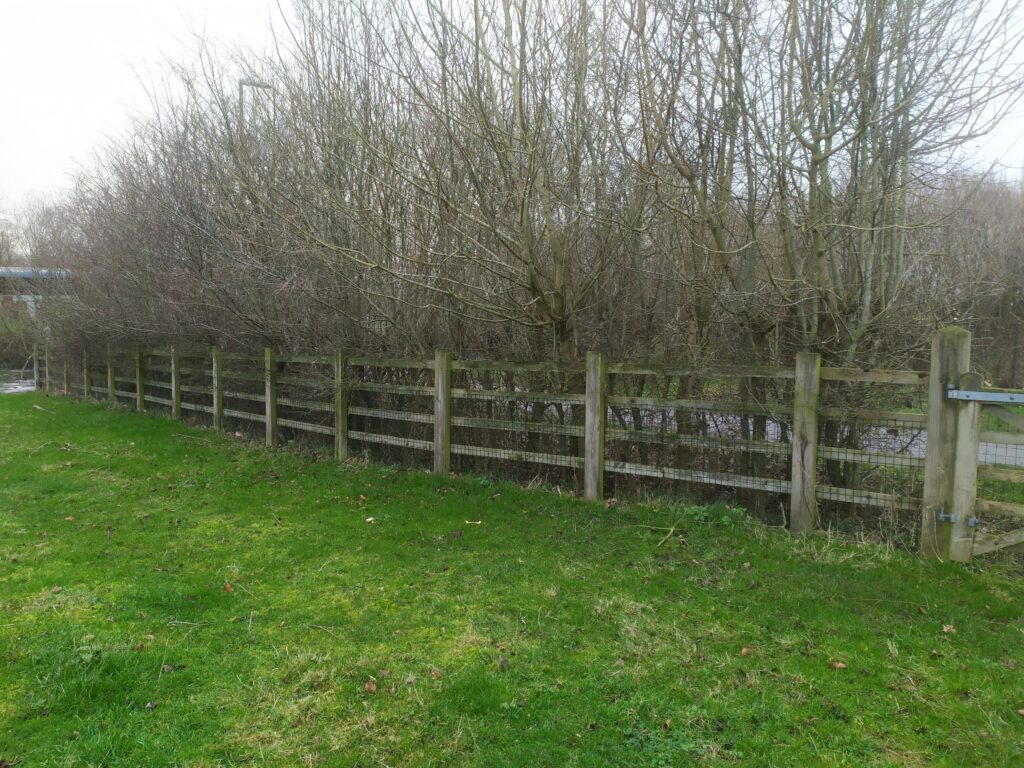
You will see from the photographs that the hedge had been left for some years and had started to race. It was very thin and of fairly low value as a habitat. The idea behind laying it, is to create a dense, thick mass of hedge that is impenetrable to anything larger than our target species. We know we have mice, shrews and hedgehogs in the vicinity, but no signs of any living in the hedgerow. If we provide a decent habitat we have local residents waiting to move in, which is great for them and our goal. It could also provide some useful evidence to prove the benefits of such simple and easy conservation; which can encourage and inform others considering similar projects.
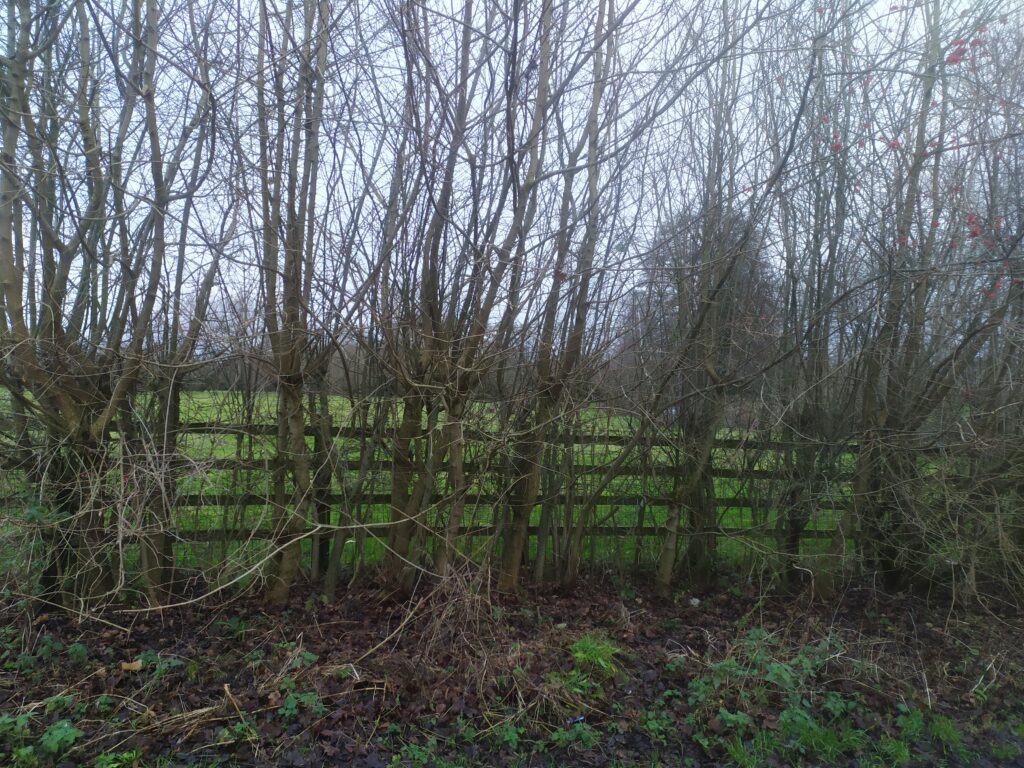
Technique
Firstly, thank you for all the informative hedgelaying information online to all the people who have contributed. I do hope you would like our efforts today.
We didn’t conform to any traditional style as such, I would say loosely Somerset, with influences of random ideas based on the challenges we faced. The hedge was laid some twelve years ago and had been cut about six years ago by a tractor and flail at about 6′. This meant the hedge was threadbare below that level, with a knotty junction of shoots where it was cut. These shoots had then raced, creating long, thin, tangled poles up to 20′ high. They weren’t really trees, but neither was it a hedge. What was more challenging, is that the trunks had become very wide, up to 6″, which is very thick to lay.
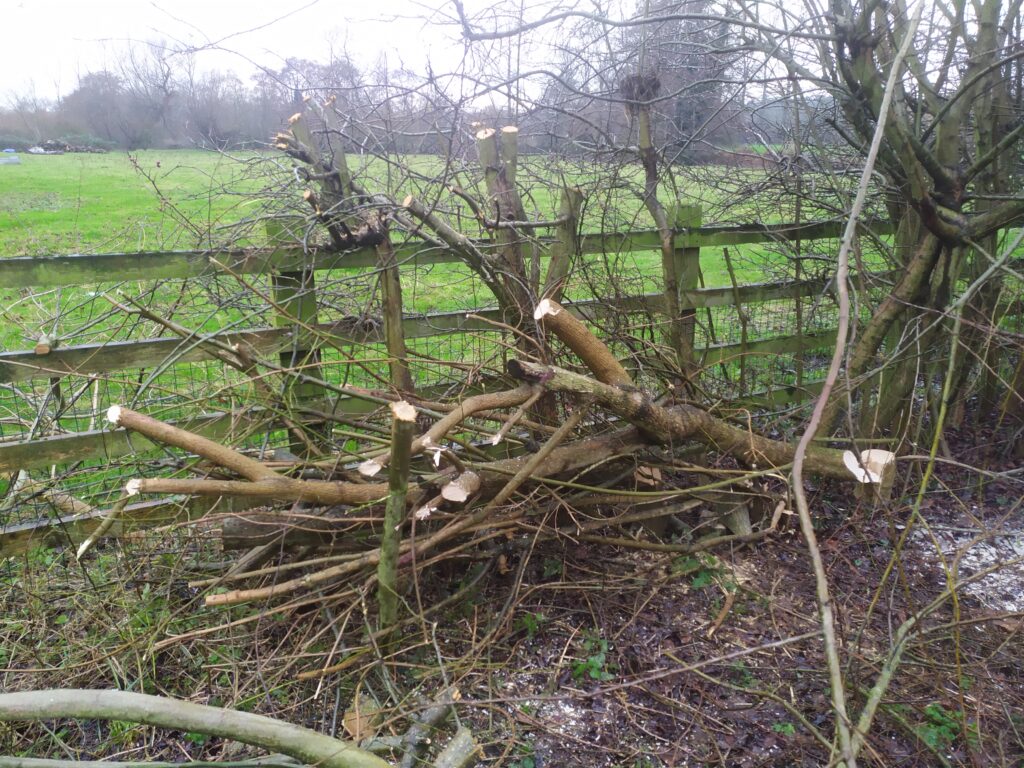
Regardless of style or finesse, the basic principal remains the same; we cut through most of the trunk, until we are able to bend the trunk down and lay the hedge. With each layer laid on top of the last, with some sort of uniform height and angle. This is what creates the density as you will see from the photographs. We then cut poles from our offcuts, that have a branch sticking out to create a hook and drive them in to fix the hedge in place whilst it regrows.
It looks pretty brutal. With cuts going about 4/5th through the trunk. You could be forgiven to thinking they will not survive. However, that bit we left intact is sap wood, alburnum by its proper name. A tree trunk has layers, the bark on the outside, the sap wood underneath that, and then heart wood in the middle, the proper name of which is duramen. The heart wood is the hard and strong bit, like your bone; but the sap wood is pretty flexible, so by cutting from one side through the heart are left with a bendy tree. The sap wood, which as my simplistic name implies, is where the sap is, like your arteries and veins. As long as we leave enough sap wood, the tree will happily reroute supply and continue to grow.
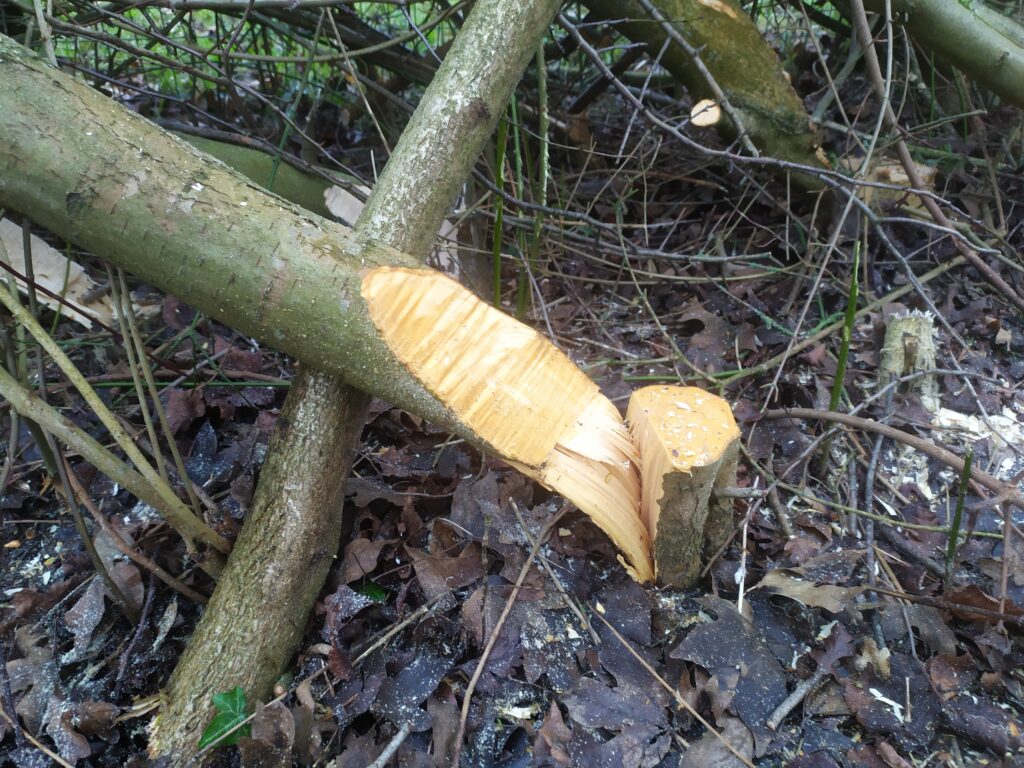
This also has a bit of a shock factor to the tree, which works in our favour. Many species of tree used in hedging, in particular Hazel, will form clumps of shoots from the ground. Cutting them an inch or two from the ground encourages this behaviour, such as in Coppicing; which is similar to hedgelaying in many ways. We could have just cut it all off at ground level and it would grow back denser. SO the stumps we have cut will produce more trees. Also, in shock, the tree will shoot more, flower more, fruit more, in a survival panic. Don’t worry the panic doesn’t hurt the tree, quite the opposite, it just fights harder and grows more shoots. But quicker thinner shoots, ideal for a dense hedge.
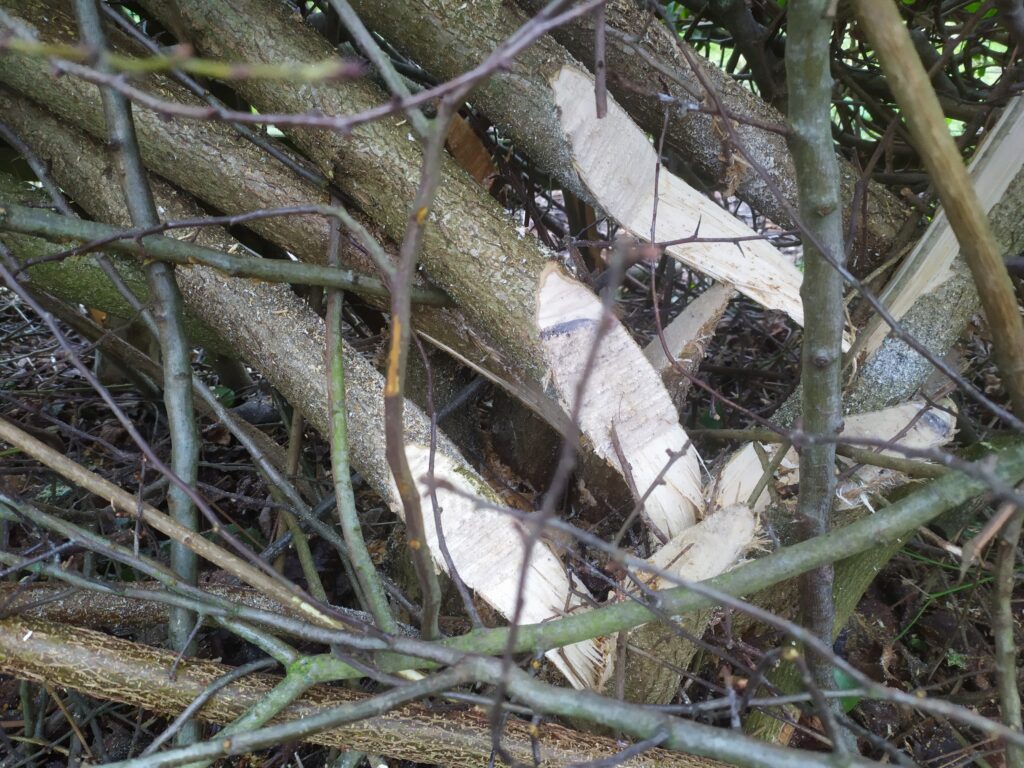
The trees cut to just sap wood are pliable and in some cases can be brought right down to the ground. In which case a hook is made from a tree y shaped tree branch, to push the stem against the ground. This will often result in it rooting, creating another source of nutrients, even though it is still supplied through what is left of its original trunk. Due to the age of this hedge and resulting width of trunks, we had very little opportunity to do this. There were a few long stems we managed to eave through and down to the ground, where they were dutifully pegged.
It was good to see that the hedge was already spreading laterally underground, with new shoots appearing next top established trunks. This all contributes to our densely packed hedge, that ultimately creates a safe and secure fortress for our beloved wildlife.
Seasonal
It was pretty cold today, we were all wrapped up; but this is the time of year for tree work on many levels. Most importantly there aren’t any birds nesting in the trees! But also many other advantages for us and the trees, because of their seasonal lifecycle.
Trees store most of their sap underground in winter. Roughly speaking, the volume of a tree’s roots underground are the same as you see above ground. But the weight moves around each year. A tree doesn’t simply shed it’s leaves, but extracts the energy from them when they are no longer useful in the shorter days, and stores that energy for next year. It is only once the tree has removed the energy that the leaf becomes brown and falls off. Equally the branches contain a lot of sap in the summer, which is stored underground during the winter. What remains of the tree above ground during winter is largely dormant.
So if we are to cut and injure trees, let’s do it whilst they are most dormant and most of their energy is underground. If we are to remove pieces of them, lets do it whilst they contain less energy. This means the tree will not suffer, but have the energy stored to respond to the pruning by fighting back stronger.
It also means that the trees are much lighter as they contain less sap, which is mostly water and heavy. So from our perspective it is safer and easier to work with. It is also the time of year where perennial weeds, such as stinging nettles have also died off to their roots; making pain free access to the stumps easier.
This is also why we lay the hedge uphill, so the sap can rise next year in a more natural fashion. Uphill in this case also means south; so I expect our rejuvenated hedge to continue to grow at this angle, creating a mass of habitat for all creatures great and small.
The Results
As ever, we need to monitor the regrowth and usage by species, to provide evidence of success and further promote DIY wildlife friendly landscape rejuvenation. But we are really pleased with the results of our labour today, and can see a new habitat emerging as the fruits of lour labour.
